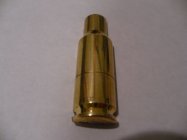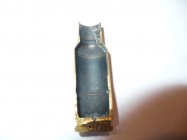Can anyone give me insight into what causes this failure on a 30BR case. Please notice the ring on the OD and ID of the case. The ring is 360 degrees of the case and is extremely uniform as if it was scored by a tubing cutter. Please ignore the ugly stain on the inside of the neck of the case as that is a residual stain from solvent used to clean case for viewing in picture.
Specifics:
Lapua case
34.8g H4198
Fed 205M primer
116g bullet
9.5 neck thickness
approx 25 reloads on case
No other case shows any sign of stress failures, cracking or other indications of problems. Primer still seats with normal resistance. Last time out with these cases and load, gun fired a .076' three shot group at 100yds. Each of my 185 cases has this high of a reload count, but this is the only case that has shown any 'apparent' problems.
I will never be too proud or too good to not listen to those who know more than me. Any logical suggestions appreciated.
-

P1020273.JPG
39.5 KB
· Views: 260
-

P1020275.JPG
35.7 KB
· Views: 259
Case stretch/overload/etc.
Have you checked the insides of your other cases? Sharpen the wire of a paper clip, bend the end at 90 degrees, and start dragging this on the inside of your other cases.
Thanks for the suggestion.
I have not inspected the inside of any other cases. I have read of the bent wire method but have not tried it. Do flaws such as this generally start on the ID of the case and do not become apparent on the OD until the flaw becomes severe?
It looks like a classic example of case stretch. Several questions:
1. How are the cases sized?
2. What is the action?
3. Are there any pressure signs?
The 'paper clip' method is one good way to detect incipient case failure. If you have access to a bore scope, a quick look inside the cases will tell a lot.
Sleepygator thanks for the help.
1. The cases are full length sized with a custom die.
2. The action is a Panda with a Krieger barrel.
3 No other pressure signs. ie flat primers, stiff bolt, cracks, etc.
I mostly shoot score but periodically attempt group shooting. This combination with these cases have proven to be competitive where ever I have entered it either for score or group.
What is the expected life of a 30BR cartridge and other than catastrophic failure, what signs should I be looking for that signify end of life for a case?
Nothing wrong with that action, the Panda is a class act. I would check fired cases against resized cases to see whether you are setting the shoulder back too far. More than .002 is not needed or recommended. In 6BR, I normally neck size but anneal and bump the shoulder .002 every third firing or so.
In a strong, rigid action like the Panda, the possible sequence of events goes like this...
- cartridge is driven forward against the chamber shoulder by the firing pin before ignition.
- case walls just behind the shoulder,thinnest) expand with pressure and grip the chamber.
- pressure against the case head pushes the head against the bolt face, stretching the case just forward of the web.
More flexible actions, particularly rear-locking, might permit high-pressure loads to stretch, even with properly sized cases. I had this problem in a Steyr SSG before realizing the amount of stretch the rear-locking action was allowing. That should never be an issue with your Panda.
Cartridge brass is an alloy of 70% Copper and 30% Zinc. It has a yield strength of 68-78 ksi in a typical case head and body. That yield is insufficient to resist >50 ksi chamber pressures if there is room to expand. The longitudinal stress on unsupported case walls can easily exceed 150 ksi. This is why it is important to keep your case dimensions as close as possible to the chamber dimensions. Even if only a little stretching is allowed, repeated firing will eventually cause failures as we see here.
Check the rest of the cases with a wire or bore scope. If more than 10% show stretching, I would consider scrapping the lot. I have certainly heard of more reloads, but 25 is not bad. Brass, even Lapua, is not so expensive to risk head separations. Also, always make sure that your cases and chamber are dry and clean of any lubricant. Any lubrication will exacerbate the problem.
M.Ezell
Gold $$ Contributor
How much are you bumping the shoulder back when resizing the brass? The problem you have is one of the brass stretching and then sizing too much, compounding the problem. Toss all of the brass and start over if there are more than 1 or two showing this. The brass is going to fail. Set your sizing die to bump the shoulder about .001'. ---Mike Ezell
gunsandgunsmithing said:
How much are you bumping the shoulder back when resizing the brass? The problem you have is one of the brass stretching and then sizing too much, compounding the problem. Toss all of the brass and start over if there are more than 1 or two showing this. The brass is going to fail. Set your sizing die to bump the shoulder about .001'. ---Mike Ezell
I am definitely not a specialist or all knowing of the nuances of when and how to 'shoulder bump'. The small amount of research I have done shows the need for shoulder bumping to be a tradeoff between overstressing the case and proper fit but also polemic in nature. I am using a Redding competition shell holder,.002') to attempt shoulder bumping. I will be the first to admit I am not clear on exactly how to measure the before and after to ascertain whether or not I have bumped the shoulder and how much. If you have suggestions, I would like to hear them.
I am curious as to why the case has chosen to separate at exactly the area it did and why it is doing it in such a symmetrical and consistent manner.
faster45432: I've been using the 'Hornady Lock-N-Load Headspace Gauge Tool', Sinclair catalog#2009-B, page 37, $36.75, Part#HK-66, for a lot of years now,,previously made by Stoney Point), and watch headspace length very closely. When having a new chamber cut, I'll take one of the first cases fired, hand punch out the primer, clean the case, and take the as fired, headspace length dimension for that chamber, recording that measurement, then adjusting the Redding FL bushing die sizer to no more than .002' shorter. Have never seen the impending case head seperation 'ring' as your excellent pics show, and one batch of 6BR Lapua has 28 loadings now, although the primer pockets are starting to get lose, so a few more loadings & they will get tossed. As mentioned, you may be setting the shoulders back just a little more than is req'd. I try to keep the cases sized so that there is a little resistance when closing the bolt: tells me the cartridge is 'snug' in the chamber, front to back, and with the tight, fitted neck, there just isn't anyplace for the brass to go.
faster45432: One point not mentioned: How much and how often do you have to trim/shorten your cases? I'm able to reload upwards of 8 to 10 times without having to trim case lengths, and when I do it's only .003' or .004' thousandths. Some brass, like my 220 Russian/6ppc have been loaded up to 20 times, and I've never had to trim: they just do not stretch.
have you done a chamber cast??
is it a chamber fault?
P
A headspace tool like the Stoney Point mentioned or the Sinclair tool is the correct way to measure case length. Use a gauge when setting up your die and set the 'bump' at .001-.002.
The reason the case separates so cleanly at that point is a reflection of Lapua alloy consistency and case uniformity. As previously mentioned, the thinner part of the case behind the shoulder will expand to grip the chamber walls. The same pressure is also exerted on the case head area around the primer, pushing back toward the bolt face. At some point on the increasingly thick case wall, the rearward force is able to overcome the radial force and cause the brass to move. This is a function of alloy yield strength and chamber pressure. If the alloy were less consistent, either in chemistry, material condition or case wall thickness, you would see a less well-defined separation.
Also, until you can get a head space tool you can take a new case fire it two times then set you die to touch the shoulder on that case. That will keep you from over bumping your shoulders.
sleepygator, has it right. No need for a chamber cast after 25 firings. 25 may be all you get! This looks like a classic case stretch failure.
faster45432 said:
I am definitely not a specialist or all knowing of the nuances of when and how to 'shoulder bump'. I am using a Redding competition shell holder,.002') to attempt shoulder bumping. I will be the first to admit I am not clear on exactly how to measure the before and after to ascertain whether or not I have bumped the shoulder and how much. If you have suggestions, I would like to hear them.
Here's a couple of pics that show how to measure the shoulder 'bump' using the Stoney Point/Hornady tool.
This pic shows a fired case measurement. The primer needs to be removed so as not to influence the reading:
This pic shows the case with the shoulder 'bumped' back .002:
In all my 30BR tinkerings, I've never seen a Lapua case fail where yours has. That your other cases don't show this makes me believe it's possibly a fluke deal with that one case. Regardless, the amount of shoulder 'bump' that you're doing is something that you can't guess at...you need to know
exactly how much you're moving that shoulder back.
Setting the die by feel is a bad way to go.....it's possible for the die not to be sizing the shoulder/body junction enough,not uncommon with the BR cases). You can end up moving the shoulder back .010-.015 before it 'feels' like it should. And as much as I love Redding products, their Competition shellholders are not always what they are marked.
For what it's worth. -Al
Frank and Al,
Thanks for the part numbers,suggestions and the clear pictures. I had a very cursory understanding of bumping and case stretch but like most things in life, you never really worry about the ramifications until it directly impacts you.
I have trimmed my cases to 1.500' and after approx 8 reloads, the average case length is 1.505 with a Standard Deviation of .002 Once I see the pictures of how to measure the case stretch and did more research, it now starts to become clear. Like the old adage, all things are clear once understood. Thanks to the great feedback from this forum it looks like my course of action is:
1. Internally inspect all cases for signs of impending failure
2. Purchase the Sinclair tool and make the exact measurements and eliminate guessing.
3. Use the appropriate shims or shell holders to adjust as needed.
As a result of 25 years as an engineer, I am much more comfortable dealing with absolute data rather than speculation and guesswork. I appreciate everyone's feedback and attempts to save me from making the same mistakes which probably gave them the experience they are now graciously conveying to me.
Thank you
Craig














